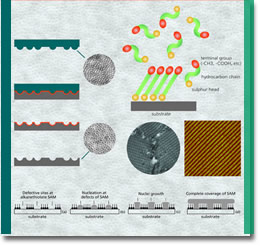 |
||||||||

Nanotecnología
CIENCIAS BASICAS, FISICA DE LA MATERIA CONDENSADA - MATERIA BLANDA
Laboratorio de Caracterización de Sistemas Blandos
El trabajo del laboratorio se centra en la caracterización estructural y electrónica de sistemas nanoestructurados basados en materia blanda (polímeros naturales y sintéticos, superficies poliméricas, coloides, etc.) Con dimensiones características en la escala entre 1 y 1000 nm.
El objetivo de nuestra investigación es explorar la novedosa fisicoquímica exhibida por la materia blanda cuando se estructura a escala nanométrica. A estas escalas las propiedades surgidas del confinamiento estructural (tamaño) y topológico (forma) se acoplan con la alta responsividad de la materia blanda ante estímulos externos (temperatura, presión, campos, etc.) dando lugar a comportamientos sinérgicos y propiedades no observadas en sistemas “masivos”.
El trabajo del grupo orienta a la caracterización de estos sistemas y se realiza mediante la activa colaboración con otros laboratorios de INIFTA y grupos de otras Instituciones argentinas y extranjeras.
Las técnicas experimentales extensivamente utilizadas por el grupo están basadas en el uso de radiación electromagnética:
Dispersión de rayos X a bajo y alto ángulo con incidencia normal y rasante (SAXS/WAXS y GISAXS).
Reflectometría de rayos X (XRR)
Fluorescencia de luz UV/visible
Espectrometría de absorción UV/visible e infrarroja
Espectroscopía de absorción de rayos-X (EXAFS/XANES)
Integrantes del grupo
Coordinador
Dr. Marcelo R. Ceolín
Colaboradores
Agustín Picco
Principales publicaciones del grupo referidas al
proyecto
(2007 - 2011)
* “Thermoreversible formation and negative thermal expansion of supramacromolecular assemblies of unimolecular micelles in solution.”
A.S. Picco, B. Yameen, O. Azzaroni y M. Ceolín
Chemical Communications, 47 (13), 3802-3804 (2011).
* “Electrochemical sensing platform based on polyelectrolyte-surfactant supramolecular assemblies incorporating carbon nanotubes.”
M.Cortez, M.Ceolín, O.Azzaroni y F.Battaglini
Analytical Chemistry, 83, 8011-8018 (2011).
* “Structure and stability of the neurotoxin PV2 from the eggs of the apple snail Pomacea canaliculata.”
M.V. Frassa, M. Ceolín, M.S. Dreon y H. Heras
Biochimica et Biophysica Acta - Proteins and Proteomics, 1804 (7), 1492-1499 (2010).
* “Tuning size and thermal hysteresis in bistable spin crossover nanoparticles.”
J.R. Galán-Mascarós, E. Coronado, A. Forment-Aliaga, M. Monrabal-Capilla, E. Pinilla-Cienfuegos y M. Ceolin
Inorganic Chemistry, 49 (12), 5706-5714 (2010).
* “A bioinspired approach to the synthesis of bimetallic CoNi nanoparticles.”
N. Gálvez, E. Valero, M. Ceolin, S. Trasobares, M. López-Haro, J.J. Calvino y J.M. Domínguez-Vera
Inorganic Chemistry, 49, 1705-1711 (2010).
* “Mössbauer thermal scan study of a spin crossover system.”
P. Mendoza-Zélis, G.A. Pasquevich, F.H. Sánchez, A.F. Cabrera, M. Ceolín, M. Monrabal-Capilla, E. Coronado y J.R.Galán Mascarós
Journal of Physics: Conf. Series, 217, 012017 (2010).
* “Redox-active concanavalin a: Synthesis, characterization, and recognition-driven assembly of interfacial architectures for bioelectronic applications.”
D. Pallarola, N. Queralto, W. Knoll, M. Ceolin, O. Azzaroni y F. Battaglini
Langmuir, 26 (16), 13684-13696 (2010).
* “Collision-mediated transfer of fatty acids from Yarrowia lipolytica sterol carrier protein 2 to phospholipid membranes.”
L.J. Falomir-Lockhart, N.I. Burgardt, R.G. Ferreyra, M. Ceolin, M.R. Ermácora y B. Córsico
Biophysical Journal, 97, 248-256 (2009).
* “Biophysical characterisation and urea-induced unfolding of recombinant Yarrowia lipolytica sterol carrier protein-2.”
N.I. Burgardt, R.G. Ferreyra, L.J. Falomir-Lockhart, B. Córsico, M.R. Ermácora y M. Ceolin
Biochimica et Biophysica Acta, 1794, 1115-1122 (2009).
* “Isolation and characterization of a novel perivitellin from the eggs of Pomacea scalaris (Mollusca, Ampullariidae).”
S. Ituarte, M.S. Dreón, M. Ceolín y H. Heras
Molecular Reproduction and Development, 75, 1441-1448 (2008).
* “Structural aspects of the growth mechanism of copper nanoparticles Inside apoferritin.”
M. Ceolín, N. Gálvez, P. Sánchez y J.M. Domínguez-Vera
European Journal of Inorganic Chemistry, 5, 795-801 (2008).
* “First egg protein with a neurotoxic effect on mice.”
H. Heras, M.V. Frassa, P.E. Fernandez, C.M. Galosi, E.J. Gimeno y M.S. Dreon
Toxicon, 52, 481-488 (2008).
* “Global shape and pH stability of ovorubin, an oligomeric protein from the eggs of Pomacea canaliculata.”
M.S. Dreon, S. Ituarte, M. Ceolin y H. Heras
FEBS Journal, 275, 4522-4530 (2008).
* “Comparative Structural and Chemical Studies of Ferritin Cores with Gradual Removal of their Iron Contents.”
N. Galvez, B. Fernandez, P. Sanchez, R. Cuesta, M. Ceolin, M. Clemente-Leon, S. Trasobares, M. Lopez-Haro, J.J. Calvino, O. Stephan y
J.M.Dominguez-Vera
Journal of the American Chemical Society, 130, 8062-8068 (2008).
* “Thermal induced phase transitions and structural relaxation in apoferritin encapsulated copper nanoparticles.”
M. Ceolin, N. Galvez y J.M. Dominguez-Vera
Physical Chemistry Chemical Physics, 10, 4327-4332 (2008).
* “PAC research in biology.”
CY. Chain, M. Ceolin y A.F. Pasquevich
Hyperfine Interactions, 181, 99-106 (2008).
* “Carotenoid binding, structure and stability of the carotenoprotein ovorubin from eggs of Pomacea canaliculata.”
M.S. Dreon, M. Ceolín y H. Heras
Archives of Biochemistry and Biophysics, 460, 107-112 (2007).